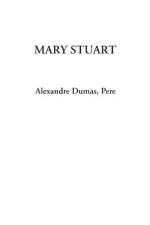At that moment the queen’s headdress falling, disclosed her hair, cut very short, and as white as if she had been aged seventy: as to her face, it had so changed during her death-agony that no one would have recognised it had he not known it was hers. The spectators cried out aloud at this sign; for, frightful to see, the eyes were open, and the lids went on moving as if they would still pray, and this muscular movement lasted for more than a quarter of an hour after the head had been cut off.
The queen’s servants had rushed upon the scaffold, picking up the book of Hours and the crucifix as relics; and Jeanne Kennedy, remembering the little dog who had come to his mistress, looked about for him on all sides, seeking him and calling him, but she sought and called in vain. He had disappeared.
At that moment, as one of the executioners was untying the queen’s garters, which were of blue satin embroidered in silver, he saw the poor little animal, which had hidden in her petticoat, and which he was obliged to bring out by force; then, having escaped from his hands, it took refuge between the queen’s shoulders and her head, which the executioner had laid down near the trunk. Jeanne took him then, in spite of his howls, and carried him away, covered with blood; for everyone had just been ordered to leave the hall. Bourgoin and Gervais stayed behind, entreating Sir Amyas Paulet to let them take the queen’s heart, that they might carry it to France, as they had promised her; but they were harshly refused and pushed out of the hall, of which all the doors were closed, and there there remained only the executioner and the corpse.
Brantome relates that something infamous took place there!
CHAPTER X
Two hours after the execution, the body and the head were taken into the same hall in which Mary Stuart had appeared before the commissioners, set down on a table round which the judges had sat, and covered over with a black serge cloth; and there remained till three o’clock in the afternoon, when Waters the doctor from Stamford and the surgeon from Fotheringay village came to open and embalm them—an operation which they carried out under the eyes of Amyas Paulet and his soldiers, without any respect for the rank and sex of the poor corpse, which was thus exposed to the view of anyone who wanted to see it: it is true that this indignity did not fulfil its proposed aim; for a rumour spread about that the queen had swollen limbs and was dropsical, while, on the contrary, there was not one of the spectators but was obliged to confess that he had never seen the body of a young girl in the bloom of health purer and lovelier than that of Mary Stuart, dead of a violent death after nineteen years of suffering and captivity.
When the body was opened, the spleen was in its normal state, with the veins a little livid only, the lungs yellowish in places, and the brain one-sixth larger than is usual in persons of the same age and sex; thus everything promised a long life to her whose end had just been so cruelly hastened.




